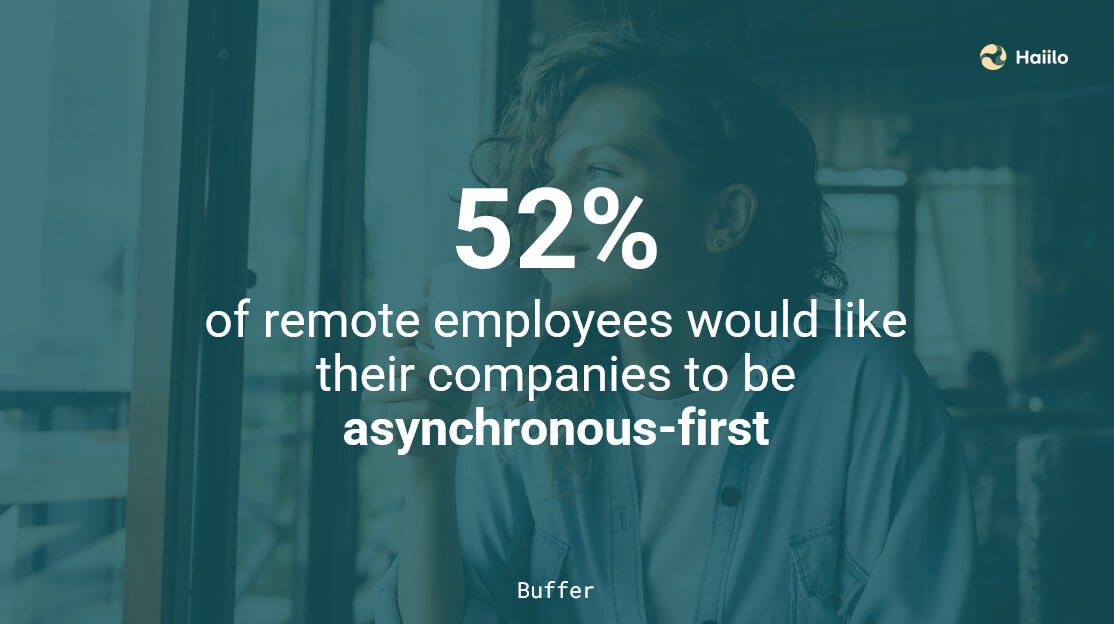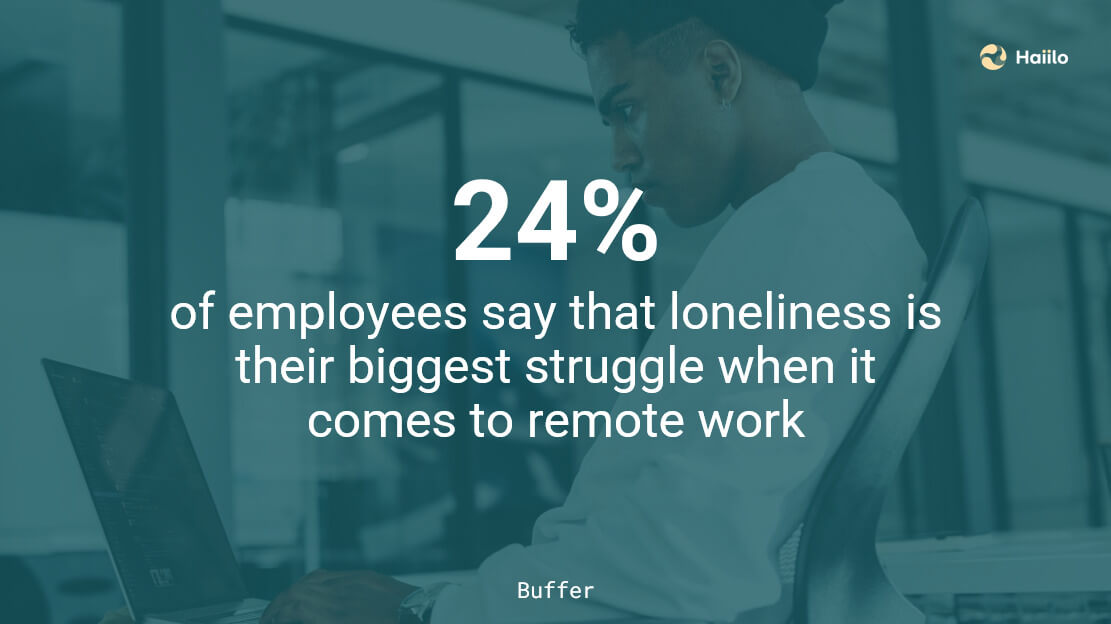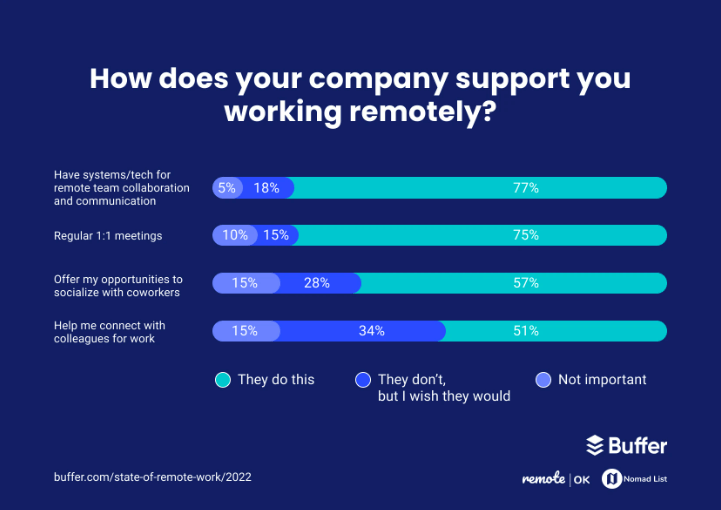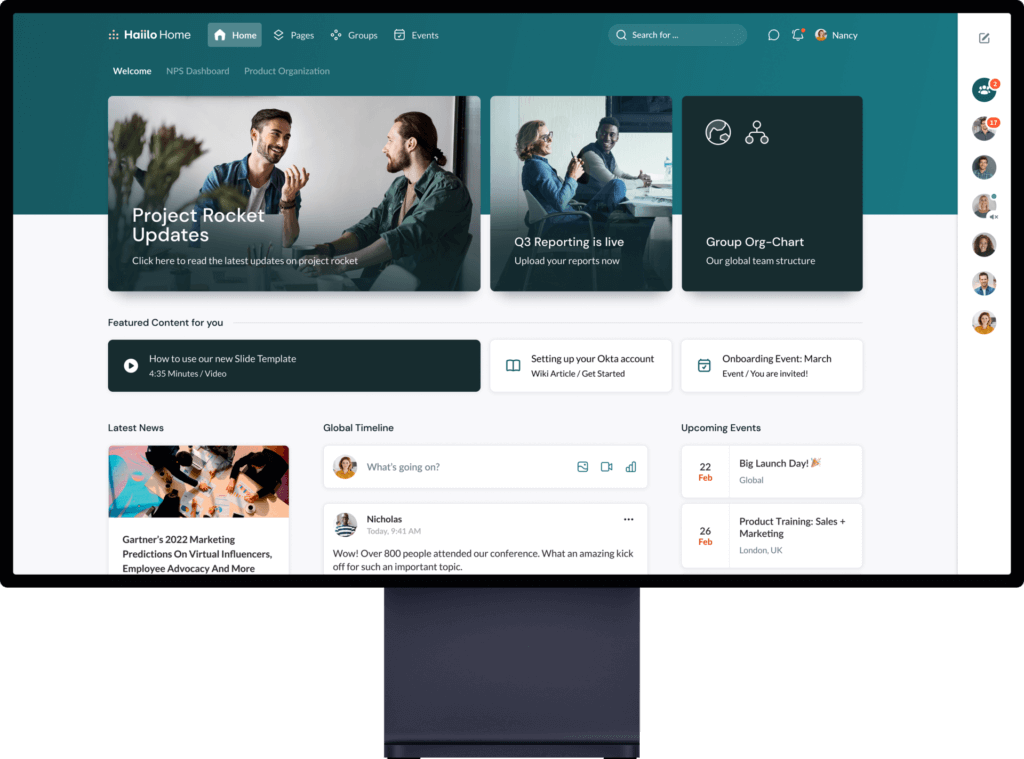More and more people across the globe depend on virtual communication. Even though remote work has its negative sides, the positive ones seem to be much more significant and employees are not ready to give them up.
Hence, virtual communication in both our personal and professional lives is the new normal, and we need to get used to it.
In this blog, we will cover some of the biggest struggles employees face with virtual communication but also the best practices for eliminating those.
About Virtual Communication and Its Emergence
Virtual communication is any communication that happens over technology rather than in person. Such communication can happen in real-time (synchronously) and asynchronously. Today, there are plenty of ways to communicate virtually in the workplace: via video conferencing tools, emails, instant messaging solutions, or using other employee communication and collaboration apps.
With the emergence of remote and hybrid work, virtual communication has become the main mean of communication for many organizations and employees across the world. Moreover, this number is projected to keep growing in the future as most employees prefer working remotely.
According to the latest research by Buffer, an astonishing 97% of people would recommend remote work to others, 90% of people rate their remote working experience as positive, and 72% are already a part of a fully remote or remote-first work environment.

But how are companies addressing the downsides of remote work and virtual communications? What are some of the biggest challenges and how to overcome them?
Keep reading to find out!
💡 Related: 8 Tips To Boost Employee Communications At Your Company
Top 7 Virtual Communication Challenges to Tackle
In the previously mentioned research, employees were asked about what has changed since they started working remotely. The majority (54%) of employees said “how I communicate and collaborate”. This change was on the top of their list.
But what are some challenges employees face because of this change?
Poor asynchronous communication
Virtual communication doesn’t work without asynchronous communication. Organizations need to understand that not everything can be discussed and resolved in real-time.
Unstructured workplace communication can be detrimental to our performance – people spend more time hopping from one meeting to another or replying to messages than focusing solely and mindfully on their tasks.
Communicating async, however, should have its rules and best practices to follow. Even though 62% of remote companies still don’t have an asynchronous-first work policy, 52% of employees would like their organizations to be async-first.

💡 If you are looking for inspiration, check out this great example by Gitlab!
Information loss (poor access or information overload)
When it comes to remote work, we often hear that we need to overcommunicate. However, things are not so simple. If done poorly, over-communication can lead to information overload!
And information overload can be the biggest reason why information gets lost. So instead of just overwhelming people with tons of information, a better approach would be to make information more personalized and relevant to employees.
Another reason why information gets lost in virtual communication is poor access to information, documents, and conversations. In most companies, crucial information lives in different places: intranets, drives, emails, chats, project management tools, and websites, to name a few. This makes it hard for people to find the information that they need.
Eliminating these challenges can have a substantial impact on your employees’ wellbeing, engagement, and productivity.
Cross-departmental silos
Team communication is crucial for any project success, but more and more we also depend on proper cross-functional collaboration to achieve great results.
In fact, over 29% of employees say that poor internal communication is the main reason why projects fail.

Virtual communication makes cross-departmental collaboration much harder. This is particularly true for fully remote organizations in which employees never see each other face to face.
Ignoring other people’s needs and goals is easier when you never see a person. This usually results in lack of alignment and broken teamwork.
💡 Learn about 11 reasons why business communication is crucial for company success!
Sense of loneliness and lack of belongingness
Virtual-only communication can result in a sense of loneliness among people. In fact, the biggest downsides of remote work, according to HBR research, are burnout and loneliness.
Water cooler chats (or water cooler talks) is what happens when colleagues take a break from work and socialize with each other.
This is a chance for people to talk about less stressful things, like hobbies and personal interests—fun topics not associated with work.
When we depend on virtual communication solely, these talks don’t happen. Scheduling a call to just chat about something with a colleague may seem odd to people.
On the other hand, strong connections at work can go a long way in retaining great talent. When people form strong relationships and friendships at work, they are more likely to have lower turnover rates.

Lack of organizational alignment
Research shows that nine out of ten companies fail to execute their strategic vision and that 95% of employees, on average, are unaware of or do not understand their company’s strategy. Effective alignment has been rare even before the COVID-19 pandemic, but virtual communication makes it even more challenging to achieve.
As nicely put by Katpa CEO Alex Raymond “alignment requires a common understanding of the mission of the organization, and consistency across each and every objective and plan”.
To achieve such alignment, effective workplace communication is key. Yes, we can put together a set of shared KPIs and hope that everyone works towards the same goals, but without good communication, alignment can’t be achieved.
Cultural differences and different communication skills
If you work remotely, you have probably already noticed that some people sound rude in their messages. The truth is, they probably come from a culture where people are more direct.
Understanding and assessing these cultural differences is important in virtual working environments. In some organizations, HR teams are responsible for identifying these differences and educating people about them.
💡 Learn about the most important communication skills and how to improve your interpersonal communications skills.
Decrease in employee engagement
All the above-mentioned negative sides of virtual communication can lead to lower employee engagement levels. They all have a significant impact on shaping one’s experience in the workplace, and we already know that employee experience directly influences employee motivation and engagement.
The biggest challenge here is that spotting these lower engagement levels is not so easy in virtual workplaces. Not seeing people makes it harder to spot and understand the reasons behind their job dissatisfaction.
6 Ways to Make Virtual Communication in the Workplace Work
Now that we have covered some of the biggest reasons why virtual communication can be challenging, let’s do a deep dive into how to make it more efficient.
Set some communication rules and communicate best practices
Organizations that have just switched to the virtual means of communication are struggling to adapt. Employees who are used to having meetings may have a hard time adjusting to remote work. So defining and encouraging best practices for virtual communication can have a big impact on eliminating the biggest communication barriers in the workplace.
It is on employers to enable their people and teach them how to best operate in virtual environments. Otherwise, endless meetings may result in a significant loss in productivity.
Consider implementing a regular internal newsletter about remote work best practices. Think about implementing a no-meeting day, for example. Create a designated channel or a virtual workspace where employees can share their own tips and advice.
📹 Check out our Masterclass about how to eliminate communication barriers at work!
Make content more relevant (hyper-personalization)
Information overload and content irrelevancy are the biggest reasons why people miss important information and why organizational communication fails. Even before this pandemic, 74% of people had a feeling that they were missing important company information. That number is even bigger now.
More than ever, organizations need to personalize workplace content and make it hyper-personalized to the individuals.
Scaling this process, however, is impossible without the right technology that enables robust employee filtering and segmentation. Employees should be served content that is relevant to their job roles, locations, preferences, interests, and other criteria.
Only then, you can be sure to deliver the right content to the right employee at the right time.
Enable seamless team (and cross-functional) collaboration
Teams and departments should have designated virtual workspaces and channels to communicate and collaborate on their projects and socialize.
According to previously mentioned research, 28% of remote workers wish their employer offered more opportunities for them to connect with their coworkers. And 34% of workers wish their employer would help them better connect with their colleagues for work.

While popular instant messaging and chat platforms help teams communicate better, they don’t offer additional features and functionalities for better collaboration and project management.
Remember, virtual communication requires a more structured approach to project planning, development, and execution.
Access to the right technology is critical here!
Provide an intuitive and easily accessible central content hub
People in your organization should never feel like they are left in the dark. Even if you don’t have a physical working space, you should try to recreate one.
Fortunately, modern social intranets provide an easy and intuitive way for employees to stay up to date, expand and share knowledge, engage with various company initiatives, and get to know their fellow coworkers better.

Show empathy and listen carefully
The most efficient way to improve virtual communication and employee engagement in your organization is by asking employees directly for their feedback. Regular employee surveys have, therefore, become a must for hybrid and remote workplaces.
Use short surveys to capture your people’s current state of mind, understand their concerns, and collect their ideas.
However, asking without acting is worse than not asking at all. In order to act, you need to measure!
Measure and act!
Today, many employers distribute regular employee surveys. The more important step, however, is to analyze the results and make data-driven decisions for improvement.
If done manually, this can be a time-consuming process, and this is why many organizations neglect it or don’t devote enough time analyzing employees’ feedback.
With the latest employee engagement technology enabled with artificial intelligence, this process becomes much more efficient and faster.
Interesting Facts About Virtual Communication at Work
- 49% of workers use a messaging or communication app every day for their work (including 64% of those in customer-facing roles). 98% of those said messaging + communication apps were important to their work (74% considered them very important).
- 32% of people find themselves thinking, “this meeting could have been an email” all or most of the time.
- Biggest issues with virtual meetings compared to in-person meetings are mainly centered around relatable issues and translate across industries.
-
- Technology issues (e.g. internet connectivity issues), (41% overall)
- Getting all attendees sorted on how best to use the technology (e.g. how to mute, use the camera), (31% overall) and,
- Virtual meeting etiquette (e.g. Attendees not focused/multi-tasking) or lack of engagement (27%)
- Zippia surveyed 2,000 American workers to find out how workers are coping. Here are the key findings of what workers are actually doing during Zoom meetings:
- 67% of workers are distracted during virtual meetings.
- 47% of people prefer in person meetings.
- 55% of workers admit to checking emails during virtual meetings.
- 43% of employees reported that webcams make them more productive with
the bulk of the survey reporting medium (31%) or low productivity (26%).
The Role of Technology in Enabling Virtual Communication
Throughout this blog, we talked multiple times about the role of technology in enabling virtual communication in organizations.
Moreover, without the right set of communication tools, it is impossible to make remote work work. Creating a virtual working environment in which employees are connected, well-informed, engaged, and productive is challenging but absolutely necessary for ensuring business continuity and company success.
Employee engagement platforms like Haiilo can help you:
- Create and distribute hyper-personalized content your people will want to read
- Send timely information while avoiding information overload
- Reach every worker with critical information regardless of their nature of work (mobile-first communication)
- Provide a central collaboration hub where people can create, store, and access critical documents in a matter of seconds
- Enable everyone to stay connected via intuitive chat
- Integrate with other workplace tech stack
- Help managers and leaders collect critical feedback from their employees and get valuable insights for improvement










